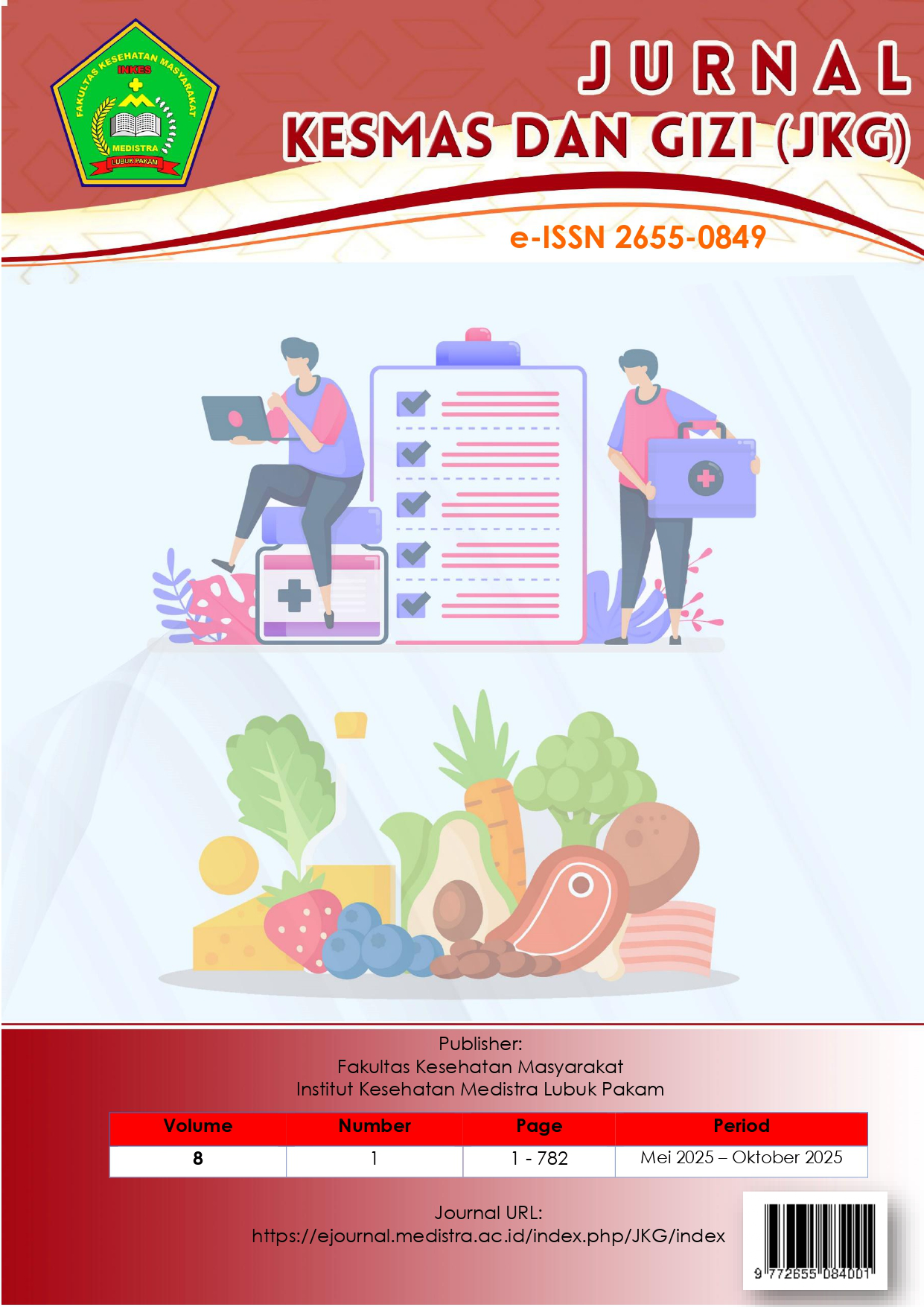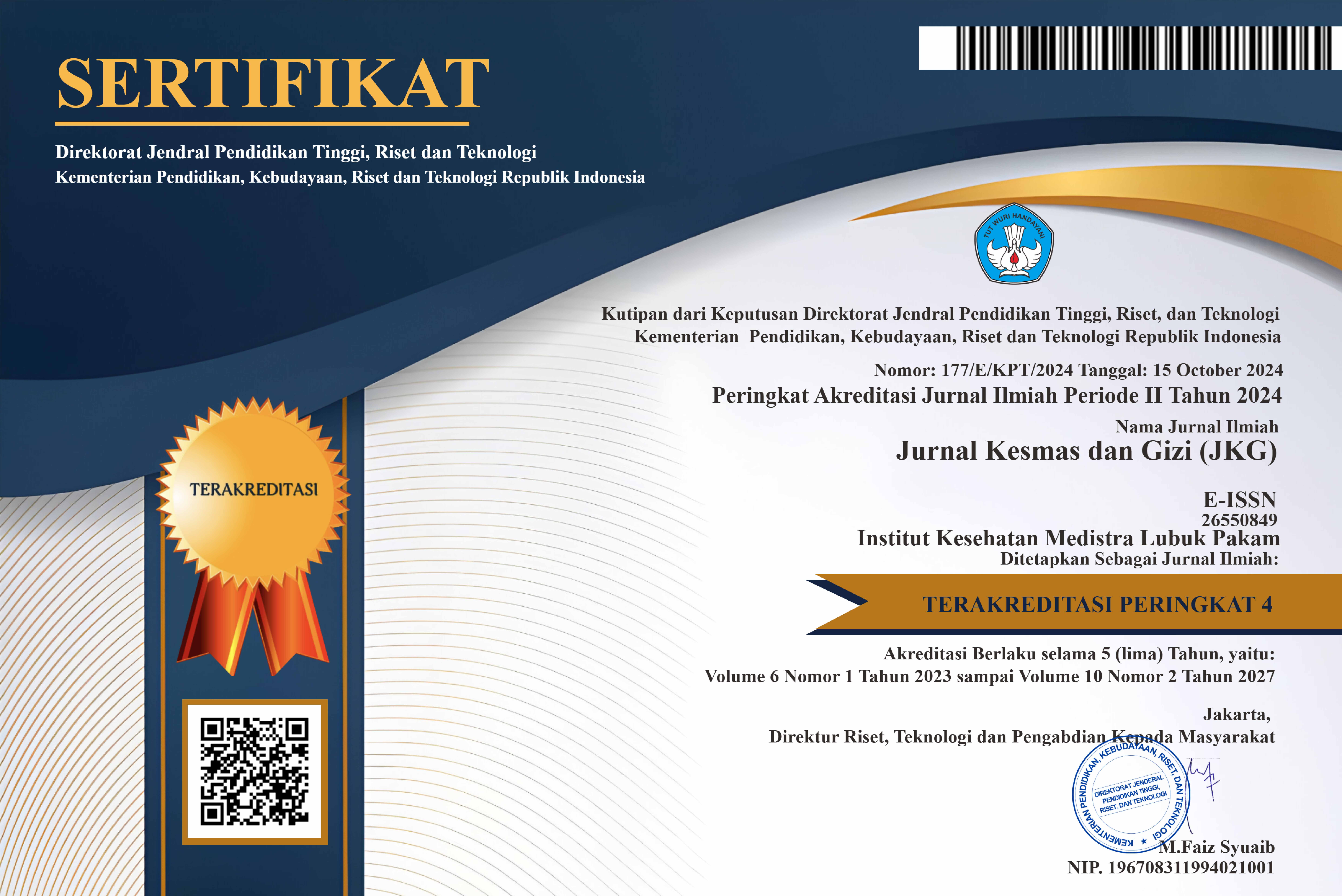The Impact of Financial Literacy and Household Food Security on the Prevention of Stunting among Toddlers in Lubuk PakamSubdistrict, Deli Serdang Regency
DOI:
https://doi.org/10.35451/j0t94544Keywords:
Stunting, financial literacy, food security, childrenAbstract
Stunting is a chronic nutritional problem characterised by a child’s height being below the standard growth for their age, which impacts cognitive development, immunity, and future productivity. This study aims to analyse the influence of family financial literacy and household food security on the prevention of stunting among children under five in Lubuk Pakam District, Deli Serdang Regency, and to determine the most dominant factor. The study employed a quantitative design with a cross-sectional method. The population consisted of 130,417 families with children aged 6–59 months, with a sample of 256 respondents selected using multistage cluster sampling. Data were obtained through anthropometric measurements of children under five and questionnaires on financial literacy and food security, both of which had been validated and reliability tested. Data analysis was conducted using univariate, bivariate (chi-square test), and multivariate (logistic regression) methods. The results revealed that low financial literacy increased the risk of stunting by 2.18 times (OR = 2.18; p = 0.004), while low food security increased the risk by 3.12 times (OR = 3.12; p < 0.001). Mother’s education (p = 0.082) and family income (p = 0.162) had no significant effect. Multivariate analysis identified food security as the most dominant factor in preventing stunting, followed by financial literacy. In conclusion, strengthening household food security and improving financial literacy through education and household financial planning should be prioritised as strategies to reduce stunting prevalence among children under five.
Downloads
References
[1] Febriani ADB, Daud D, Rauf S, Nawing HD, Ganda IJ, Salekede SB, et al. Risk factors and nutritional profiles associated with stunting in children. Pediatr Gastroenterol Hepatol Nutr 2020;23:457. https://doi.org/10.5223/pghn.2020.23.5.457.
[2] Mustakim MRD, Irawan R, Irmawati M, Setyoboedi B. Impact of stunting on the development of children between 1-3 years of age. Ethiop J Health Sci 2022;32. https://doi.org/10.4314/ejhs.v32i3. 13.
[3] Ssentongo P, Ssentongo AE, Ba DM, Ericson JE, Na M, Gao X, et al. Global, regional and national epidemiology and prevalence of child stunting, wasting and underweight in low-and middle-income countries, 2006–2018. Sci Rep 2021;11:5204. https://doi.org/10.1038/s41598-021-84302-w.
[4] Quamme SH, Iversen PO. Prevalence of child stunting in Sub-Saharan Africa and its risk factors. Clin Nutr Open Sci 2022;42:49–61. https://doi.org/10.1016/j.nutos.2022.01.009.
[5] Sumon IH, Akter S, Sujon MSH, Alam MK, Yasmin S, Yeasmin S, et al. Determinants of stunting among children: Evidence from the Cambodian Demographic and Health Survey 2021–2022. Child Care Health Dev 2024;50:e13291. https://doi.org/10.1111/cch.13291.
[6] Vyas S. A systematic review on nutritional vulnerability and opportunity during the first 1000 days of life for ensuring better human capital. Indian J Sci Technol 2021;14:2511–6. https://doi.org/10.17485/IJST/v14i30.1253.
[7] Nyarko MJ, ten Ham-Baloyi W, van Rooyen D (R. M. Qualitative Exploration of Health Professionals’ Perceptions of Addressing Malnutrition Within the First 1,000 Days. J Nutr Educ Behav 2024;56:442–51. https://doi.org/10.1016/j.jneb.2024.03.010.
[8] Bangun SMB, Sihombing JR. The Relationship Of Exclusive Breastfeeding With Stunting Incidents In Toddlers in DT Village. J KESMAS DAN GIZI 2024;6:375–80. https://doi.org/10.35451/jkg.v6i2.2147.
[9] Firdaus SE, Maulana PD. Acceleration of stunting reduction: Advancing social and environmental well-being through policy, education, and environmental management. J Sustain Soc Eco-Welfare 2025;2:141–58. https://doi.org/10.61511/jssew.v2i2.2025.1496.
[10] Scheffler C, Hermanussen M, Soegianto SDP, Homalessy AV, Touw SY, Angi SI, et al. Stunting is a synonym of social disadvantage and poor parental education. Int J Environ Res Public Health 2021;18:1350. https://doi.org/10.3390/ijerph 18031350.
[11] Sari GM. Early stunting detection education is an effort to increase mothers’ knowledge about stunting prevention. Folia Medica Indones 2021;57:70–5. https://doi.org/10.20473/fmi.v57i1.23388.
[12] Hakim H, Wahyuni S. The Importance of Education and Knowledge of Prospective Parents in Preventing Stunting. Bull Sci Educ 2024;4:412–7. https://doi.org/10.51278/bse.v4i3.1656.
[13] Suyanto S, Wahyuni S, Zulharman Z, Restila R, Irfansya R, Aprillianty EN, et al. Understanding stunting risk factors in Kampar Regency: Insights from mothers with stunted children (qualitative study). SAGE Open Med 2024;12:20503121241244664. https://doi.org/10.1177/20503121241244662.
[14] Rizaldi MA, Ali K, Rara SMH, Panjaitan BSR. Water, sanitation and hygiene (WASH) and its association with stunting in developing countries in Asia: A systematic review. Sv?sthya Trends Gen Med Public Heal 2025;2:e81–e81. https://doi.org/10.70347/svsthya.v2i2.81.
[15] Heni H, Idaningsih A, Wianti A, Setyawati A. Identification Of Sanitation And Hygiene Risk Factors On The Incidence Of Stunting In Indonesia: A Scoping Review. Multidiscience J Multidiscip Sci 2025;2:94–109. https://doi.org/10.59631/multidiscience.v2i1.302.
[16] Unde AA, Howay NN. The Effect of Economic Status and Mother’s Knowledge in Stunting Cases: A Systematic Review. Int J 2024;5:4936–46. https://doi.org/DOI: 10.61707/qebrng58.
[17] Nurmahfuzhah N, Herawati T, Defina D. The relationship of economic pressure and financial management on parenting quality in stunted children. BIO Web Conf., vol. 153, EDP Sciences; 2025, p. 2027. https://doi.org/10.1051/bioconf/202515302027.
[18] Rahayuwati L, Komariah M, Sari CWM, Yani DI, Hermayanti Y, Setiawan A, et al. The influence of mother’s employment, family income, and expenditure on stunting among children under five: a cross-sectional study in Indonesia. J Multidiscip Healthc 2023:2271–8. https://doi.org/: 10.2147/JMDH.S417749.
[19] Bangun SMB, Sitepu WA. The Ethnic Group Role With Stunting Incidents In Sekip Village Lubuk Pakam District. J KEPERAWATAN DAN Fisioter 2023;5:375–80.
[20] Khomsan A, Rifayanto RP, Firdausi A, Adha ASA, Herdiana E, Wibowo Y, et al. Supplemental feeding and nutrition education to reduce stunting in Indonesian toddlers-The DASHAT programme. Prog Nutr 2024;26. https://doi.org/10.23751/pn.v26i1.15270.
[21] Hatijah N, Taufiqurrahman T, Buanasita A. Nutrition education with jigsaw method as an effort to prevent stunting in the Perak Timur Health Center area, Surabaya. Community Empower 2023;8:183–90. https://doi.org/10.31603/ce.7945.
[22] Sinaga EP, Bangun S, Kasim F. Evaluasi Peranan Penyuluh KB Dalam Pendampingan Keluarga Beresiko Stunting Di Kabupaten Serdang Bedagai Tahun 2022. Best J Biol Educ Sci Technol 2022;5:205–10.
[23] Girma M, Hussein A, Norris T, Genye T, Tessema M, Bossuyt A, et al. Progress in water, sanitation and hygiene (WASH) coverage and potential contribution to the decline in diarrhea and stunting in Ethiopia. Matern Child Nutr 2024;20:e13280. https://doi.org/10.1111/mcn.13280.
[24] Hakeem R, Herrera M, Jahan M. Food security and nutrition competencies diminish the role of GDP in predicting stunting variations among countries. Nurture 2023;17:427–38. https://doi.org/10.26553/jikm.2022.13.2.385-398.
[25] Twumasi MA, Essilfie G, Ntiamoah EB, Xu H, Jiang Y. Assessing financial literacy and food and nutritional security relationship in an African country. Heliyon 2023;9. https://doi.org/10.1016/j.heliyon.2023.e19573.
[26] Manan YM, Kurniawan D. Pro-Insting (Financial Inclusion Program to Prevent Stunting) for Economic Empowerment & Movement to Accelerate Financial Inclusion for Women. Ihtifaz J Islam Econ Financ Bank 2022;5:41–54. https://doi.org/10.12928/ijiefb.v2i1.847.
[27] Victora CG, Christian P, Vidaletti LP, Gatica-Domínguez G, Menon P, Black RE. Revisiting maternal and child undernutrition in low-income and middle-income countries: variable progress towards an unfinished agenda. Lancet 2021;397:1388–99. https://doi.org/:10.1016/S0140-6736(21)00394-9.
[28] Mariska A, Marniati IM. Analysis of the effect of mother’s work and family income on stunting incidence in toddlers. Work 2022;50:90. https://doi.org/10.54443/morfai.v2i1.215.
[29] Nam S-J, Suk J. Influence of health food literacy on willingness to pay for healthier foods: focus on food insecurity. Int J Equity Health 2024;23:80. https://doi.org/10.1186/s12939-024-02135-1.
[30] Arshad A. Impact of financial inclusion on food security: evidence from developing countries. Int J Soc Econ 2022;49:336–55. https://doi.org/10.1108/IJSE-08-2021-0462.
[31] Koomson I, Asongu SA, Acheampong AO. Financial inclusion and food insecurity: Examining linkages and potential pathways. J Consum Aff 2023;57:418–44. https://doi.org/10.1111/joca.12505.
[32] Yanti DS, Sumardiyono S, Kusnandar K. The relationship between household good security and incidence of stunting in toddlers during the new normal: A systematic review. Epidemiol Soc Heal Rev 2023;5:51–9. https://doi.org/10.26555/eshr.v5i1.7229.
[33] Dewi P, Khomsan A, Dwiriani CM. The Household Food Security And Stunting Of Under-Five Children In Indonesia: A Systematic Review. Natl Nutr Journal/Media Gizi Indones 2024;19. https://doi.org/10.20473/mgi.v19i1.17–27.
[34] Gassara G, Chen J. Household food insecurity, dietary diversity, and stunting in sub-Saharan Africa: a systematic review. Nutrients 2021;13:4401. https://doi.org/10.3390/nu13124401.
Downloads
Published
Issue
Section
License
Copyright (c) 2025 Sri Melda Br Bangun, Irmayani Irmayani, Basyariah Lubis

This work is licensed under a Creative Commons Attribution 4.0 International License.
Copyright in each article is the property of the Author.


























